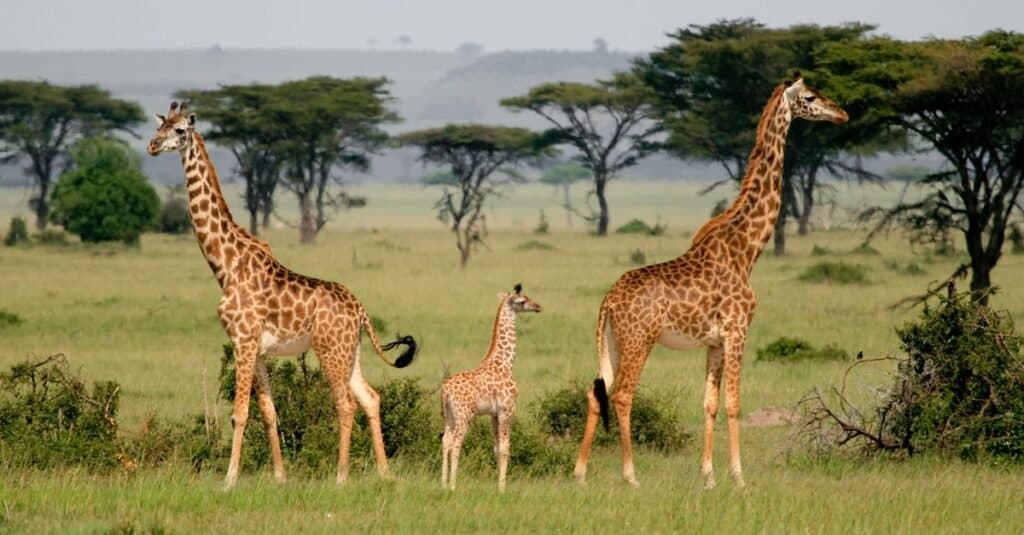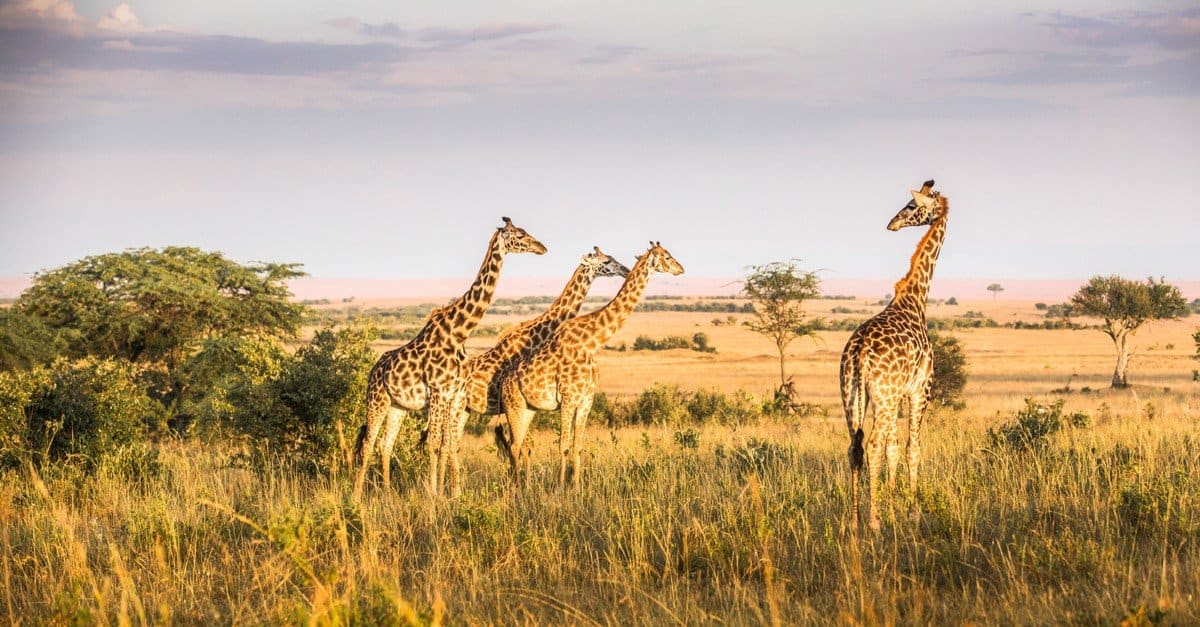Giraffes (Giraffa camelopardalis) are one of the animals that people most easily recognize. With their elongated neck and unique patterned coat, they easily stand out amongst other animals. Located in sub-Saharan Africa, these large mammals can grow up to 20 feet tall and can weigh up to 4,2000 pounds. People flock to Africa for the chance to glimpse these incredible creatures on a safari ride. Are safaris the only place you can witness these magnificent animals? Where are they located? What is the current giraffe population, and how many are left in the world? Discover the answers to all of those questions and more as we dive in and learn all about giraffes and their population.
Giraffe Population: How Many Are Left in the World?

In 2016, the IUCN Red List uplisted the giraffe, as a species, of Least Concern to Vulnerable.
©Volodymyr Burdiak/Shutterstock.com
While giraffes used to be a populous animal, their numbers are rapidly declining. According to the Giraffe Conservation Foundation (GCF), in the “1980s, the total number of all giraffe in Africa was estimated at more than 155,000 individuals.” Today, the “current estimate of the Africa-wide giraffe population is around 117,000.” While the actual drop is slightly less than the predicted drop, it is still a drastic drop in population. Furthermore, specific regions, designated as prime giraffe habitats, have experienced a 95 percent drop in population.
There are four recognized species of giraffe and several subspecies. The four species of giraffe are the Masai giraffe (Giraffa tippelskirchi), the Northern giraffe (Giraffa camelopardalis), the Reticulated giraffe (Giraffa reticulata), and the Southern giraffe (Giraffa giraffa). According to the San Diego Zoo, there have been “declines of >40% across the species’ range since the 1990s.” Below is a table that showcases an estimate of the current population by species. The San Diego Zoo takes estimates and information from both the GCF and the IUCN to determine these estimates.
| Giraffe Type | Scientifc Name | Population |
|---|---|---|
| Masai giraffe | Giraffa tippelskirchi | 32,200 |
| Northern giraffe | Giraffa camelopardalis | 4,700 |
| Reticulated giraffe | Giraffa reticulata | 8,700 |
| Southern giraffe | Giraffa giraffa | 34,500 |
Conservation Status
As the giraffe population dwindles, the IUCN Red List recently uplisted the species as a whole from Least Concern to Vulnerable. However, each subspecies has its own conservation status. You can find those conservation statuses listed below.
| Giraffe Species | Giraffe Subspecies | Conservation Status |
|---|---|---|
| Masai giraffe | Luangwa giraffe Masai giraffe | Vulnerable Endangered |
| Northern giraffe | Kordofan giraffe Nubian giraffe West African giraffe Rothschild’s giraffe | Critically Endangered Critically Endangered Vulnerable Near Threatened |
| Reticulated giraffe | Reticulated giraffe | Endangered |
| Southern giraffe | Angolan giraffe South African giraffe | Least Concern Not Threatened |
Where Can You Find Giraffes Today?

The nine different species of giraffe are all found in varying countries in Africa.
©iStock.com/bzamora
Although you may be able to see a giraffe at your local zoo, wild giraffes are only found on the African continent. While giraffes used to be widespread across the continent, the remaining populations are restricted to parts of sub-Saharan Africa. National Parks hold the largest concentration of giraffes today. While each subspecies may have its preference for geographical location, they are all found in fragmented habitats, in varying countries on the continent.
Giraffe Conservation Efforts
The steady decline of the giraffe population did not happen overnight. It is a result of constant habitat loss and fragmentation as a result of human activities. Mining, urban expansion, and agricultural development are some of the causes of this habitat loss. Additionally, people hunt giraffes, both illegally and legally, for sport and their parts (such as horns and pelts). Other factors that affect the giraffe population are death from collisions with automobiles, droughts from climate change, and inbreeding depression in isolated populations. All of this is in addition to the natural dangers that they face every day, such as predators.
Although the giraffe’s future looks bleak, conservationists are taking steps to strengthen their population. Organizations like the GCF are constantly raising awareness of giraffe conservation and are researching giraffe conservation and management. Also, conservationists are working together to identify key threats to giraffe populations and develop a network of individuals dedicated to protecting them. With that protection, they can protect giraffe habitats and work collaboratively with local communities to increase the giraffe population.
Fun Facts About the Giraffe

Because of its massive height, the giraffe has the highest blood pressure of any animal.
©PhanuwatNandee from Getty Images and blueorangestudio/ via Canva.com
- Their tongues can grow to be 18 inches long.
- Now, Africa has fewer giraffes left than elephants.
- No two giraffes have the same spot patterns.
- Giraffes eat over 75 pounds of food a day.
- Giraffes are amazing pollinators.
Thank you for reading! Have some feedback for us? Contact the AZ Animals editorial team.








